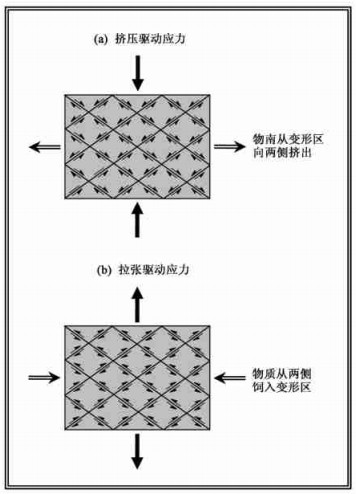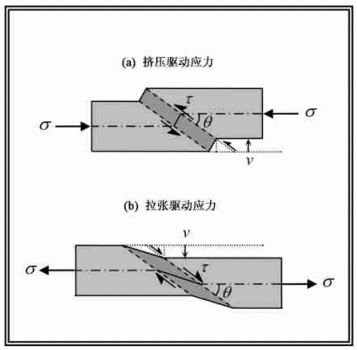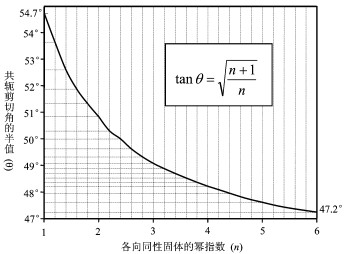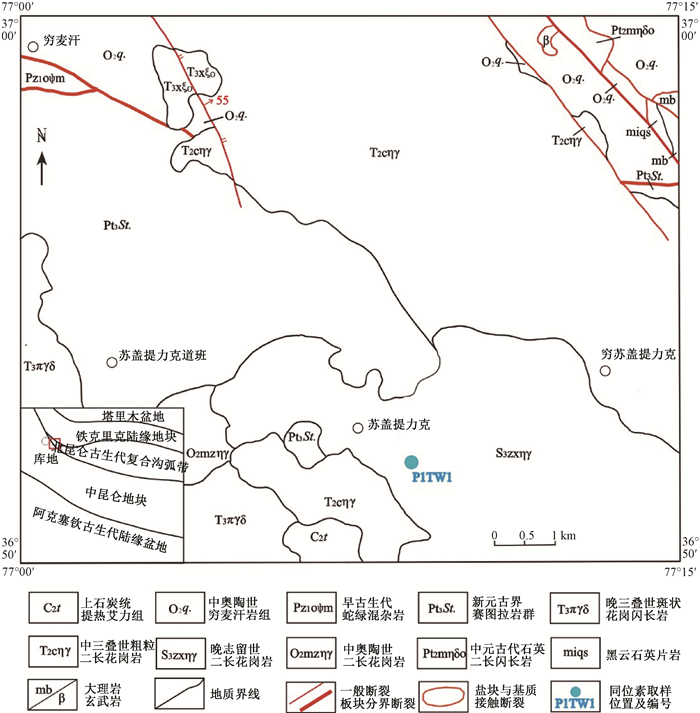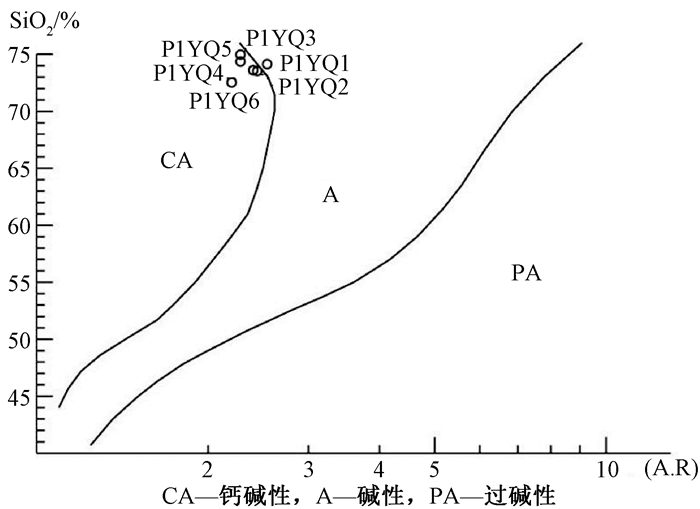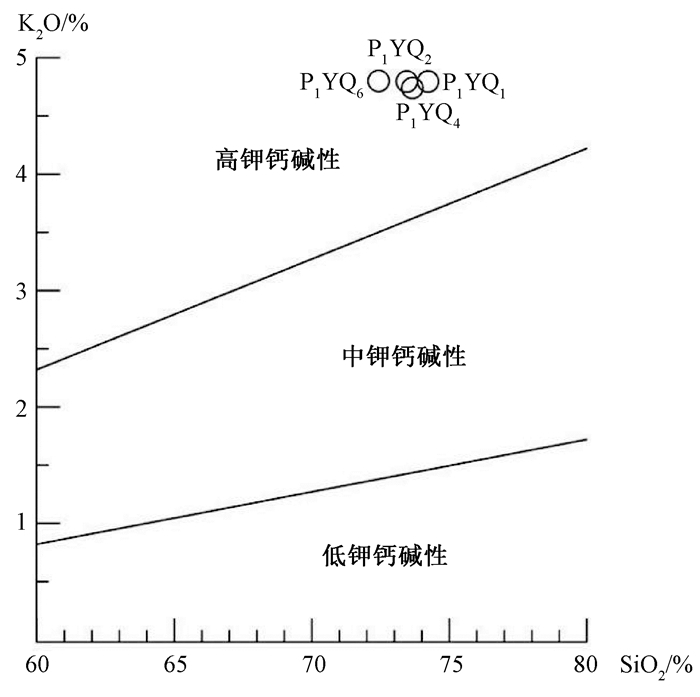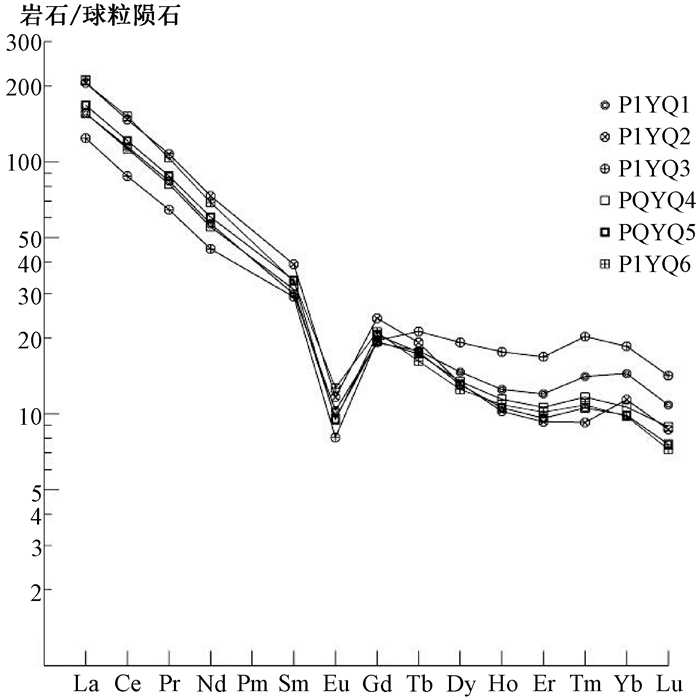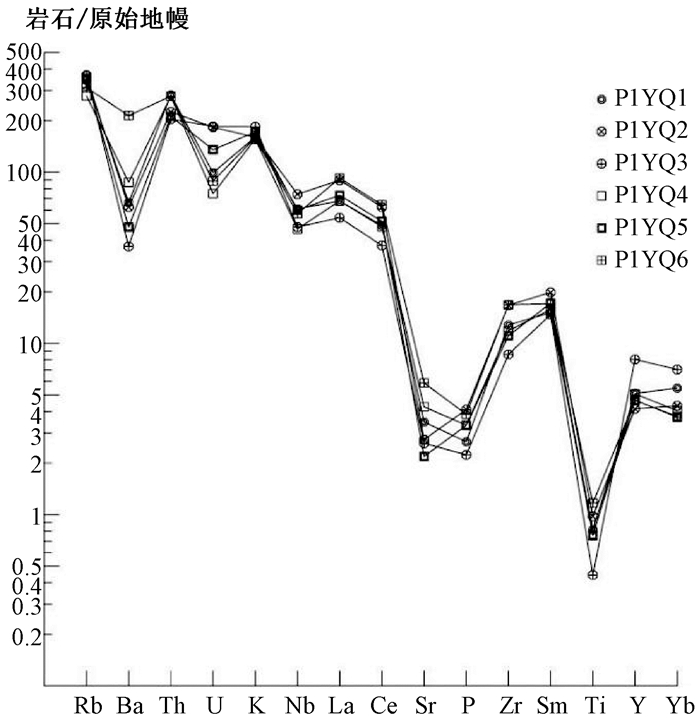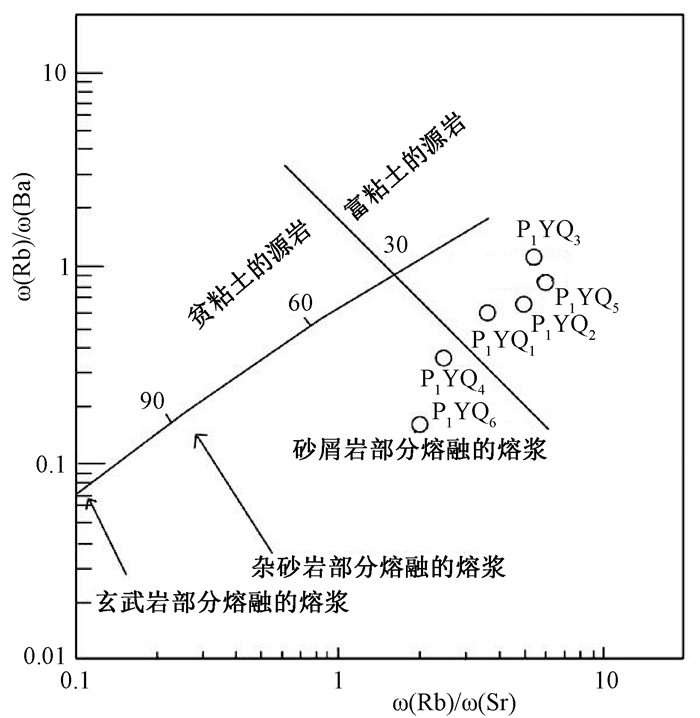RHEOLOGIC IMPLICATIONS OF CONJUGATE SHEAR ANGLES
-
摘要: 基于最大侧向位移速率假设(Maximum lateral displacement rate, 简称MLDR), 本文提出了一个关于共轭剪切角的流变学理论。根据这个假设, 无论是压应力或张应力作用在一个固体上, 剪切带总是沿着使得被剪切带分割的块体的侧向位移速率为最大的方向发育。换句话说, 如果平行于驱动应力的纵向位移速率或驱动应力的大小被看作为边界条件, 那些被剪开的块体总是以最快的可能速度从两侧挤出或饲入变形区。该理论的优点是:剪切位移的方向是可逆的。因此, 同一剪切带可以在挤压和拉张应力体系中活动。在各向同性固体中, 剪切带的方位和驱动应力方向之间的夹角θ由方程式 tan θ=
-
关键词:
- 共轭剪切角 /
- 最大侧向位移速率假设 /
- 流变学
Abstract: A rheologic theory on conjugate shear angles is proposed based on the maximum lateral displacement rate (MLDR)hypothesis, which states that when compressive or tensile stress is applied to a solid, shear bands are formed in the solid in the orientations that give rise to the maximum lateral displacement rates of the blocks divided by the shear bands.In other words, it is postulated that the sheared blocks are laterally extruded from or fed into the deformation domain at the greatest possible velocity.The merit of this theory is:the sense of shear displacement is reversible.Hence, the same shear bands can be activated in both compressive and tensile stress regimes.In an isotropic model, the angle θ between the driving stress and the shear bands formed is determined by the equation, tan θ=-
Key words:
- conjugate shear angle /
- maximum lateral displacement rate /
- rheology
-
0. 引言
塔里木盆地西南缘的西昆仑地区构造演化是地质学家十分关注的问题,古生代该地区经历了拉张—闭合—再拉张—再闭合两个构造演化阶段。柯岗—库地蛇绿岩带是加里东时期原特提斯构造域的地质表现,由于后期构造叠加、地理交通因素和地质工作程度的限制,西昆仑地区早古生代构造演化的细节不甚清楚,原特提斯洋闭合及碰撞时限不明。王元龙等[1]认为志留纪(440~410 Ma)是原特提斯洋闭合阶段;周辉等[2]研究库地煌斑岩认为404 Ma时期西昆仑构造演化转变为热隆引张的构造环境;肖序常[3]等认为原特提斯洋在古生代早期已消减闭合;郝杰等[4]认为库地超镁铁质岩构造侵位,围岩变形及变质等均发生在早古生代早期;袁超等[5]研究库地128岩体认为原特提斯洋在(471±5)Ma时期仍处于俯冲消减阶段;崔建堂等[6]认为康西瓦北侧蒙古包—普守蛇绿混杂岩的汇聚俯冲时间早于晚奥陶世;黄建国等[7]认为原特提斯洋在中奥陶世—志留纪处于消减的末期;高晓峰等[8]获得大同岩体锆石U-Pb年龄为(470.0±1.2)Ma,认为其为原特提斯洋在早奥陶世俯冲消减—碰撞过程中的产物;王超等[9]在西昆仑库地蛇绿岩北部侵入柯岗断裂的布隆二长花岗岩获得锆石U-Pb年龄(441±2)Ma,时代为早志留世,认为其是原特提斯洋俯冲的产物;黄朝阳等[10]认为奥陶纪末期原特提斯洋两侧大陆碰撞,形成同碰撞花岗岩。
已有研究对西昆仑原特提斯洋在早古生代晚期构造演化存在不同认识,具体可以概括为以下几个观点:①早奥陶世—志留纪时期原特提斯洋处于消减闭合阶段[1, 4~6, 8~9];②奥陶纪末期原特提斯洋两侧大陆碰撞[10];③早泥盆世西昆仑处于碰撞后伸展环境[2]。西昆仑库地一带发育志留纪二长花岗岩,通过对库地南志留纪苏盖提力克花岗岩开展锆石年代学、岩石地球化学研究,确定其成因类型,代表的构造环境,进而为该区早古生代原特提斯洋构造演化及闭合时限提供地质依据。
1. 区域地质背景
新疆库地南一带横跨北昆仑古生代复合沟弧带和中昆仑地块及早古生代柯岗—库地缝合带,柯岗—库地缝合带东西向贯穿研究区,是研究早古生代原特提斯洋构造演化的有利地段。库地缝合带南侧发育中昆仑地块基底新元古代赛图拉岩群、新元古代堇青二长花岗岩、奥陶纪花岗岩、志留纪花岗岩和印支期花岗岩;缝合带北侧发育早古生代库地构造混杂岩和库地蛇绿岩和印支期二长花岗岩[11]。
赛图拉岩群岩性为片麻岩、浅粒岩、变粒岩、片岩和斜长角闪岩,局部变质程度达高角闪岩相,混合岩化作用强烈;堇青二长花岗岩侵入赛图拉岩群;早古生代库地构造混杂岩为构造片岩,是原特提斯洋俯冲碰撞过程的强烈的剪切和挤压作用下,发生动力变质变形而成,苏盖提力克花岗岩侵入新元古界赛图拉岩群和堇青二长花岗岩(见图 1)[11]。
2. 岩体地质及岩石学特征
苏盖提力克花岗岩出露于库地缝合带南侧,岩性为中细粒二长花岗岩,侵入新元古代赛图拉岩群和新元古代片麻状堇青二长花岗岩及奥陶纪片麻状中粒二长花岗岩之中,同时被三叠纪二长花岗岩侵入。苏盖提力克花岗岩与赛图拉岩群侵入接触面近于直立,接触面截切片麻理;侵入接触带花岗岩具混染特征,呈浅灰绿色,混染带宽约10 m,岩体边部粒度较细。
岩石呈深灰色,中细粒花岗结构,块状构造。岩石由斜长石、钾长石、石英、黑云母、白云母组成。斜长石呈半自形板状,粒度一般0.1~2.0 mm,少量为2.0~2.5 mm;少见环带构造,含量40%~45%。钾长石呈它形粒状,少部分呈半自形宽板状,粒度一般0.1~2.0 mm,少量为2.0~2.5 mm;晶内嵌布少量斜长石、石英等小包体,局部交代斜长石,含量25~30%。石英呈它形粒状,不均匀分布,粒度一般0.1~1.0 mm;粒内可见轻波状消光,边界呈不规则状接触,含量20%左右。黑云母、白云母呈细小叶片状,杂乱分布,粒度一般0.1~0.5 mm;黑云母不均匀绿泥石化等,局部呈假象产出,副矿物有锆石、磷灰石、独居石、磷钇矿等(见图 2)。
3. 样品采集、锆石分选及分析方法
3.1 样品采集
通过对苏盖提力克一带进行系统野外调查,在中细粒二长花岗岩中共采集6件岩石地球化学样品和1件锆石U-Pb样品。其中锆石U-Pb样品采自苏盖提力克附近(见图 1,地理坐标36°41′59″N,77°08′52″E),原岩重3.73 kg,用于岩浆锆石的LA-ICP-MS定年测试。
3.2 分析方法
岩石地球化学分析测试由河北省区域地质矿产调查研究所实验室测试完成,主量元素采用碱熔法制备样品,使用AxiosmaxX射线荧光光谱仪完成分析测试,分析精度高于5%,烧蚀量、H2O+和H2O-采用P1245电子分析天平完成测试。微量元素和稀土元素采用酸溶法制备样品,使用X Serise 2等离子体质谱仪完成测试,分析精度高于5%。
用于锆石U-Pb测年样品由河北省区域地质矿产调查研究所实验室分选锆石单矿物。在双目镜下根据锆石颜色、自形程度、形态等特征初步分类,挑选出具有代表性的锆石,将待测锆石与标准锆石样品制作成环氧树脂样品靶,待样品靶固结、干燥后,进行打磨并抛光至大多数锆石颗粒中心暴露,然后拍摄可见光和阴极发光显微照片,测试时根据显微照片选取测点部位,力求避开裂隙和包裹体,以使获得的年龄值有较确切的地质意义。
锆石U-Th-Pb同位素测定在天津地质调查中心同位素实验室的LA-MC-ICP-MS上完成,测定结果中的同位素比值和年龄误差为1σ水平,使用的仪器及分析流程详见参考文献[10~14]。
4. 分析结果
4.1 LA-ICP-MS锆石U-Pb分析结果
中细粒二长花岗岩锆石主要为自形半自形柱状,从阴极发光(CL)图像(见图 3)可以看出锆石具有清晰的内部结构和典型岩浆成因的震荡环带,表明锆石是岩浆成因。
锆石LA-ICP-MSU-Pb年龄分析结果见表 1。本次测试测定25颗锆石的25个数据,测得的206Pb/238U年龄介于222~756 Ma。分析点8和12的206Pb/238U年龄为748~756 Ma位于锆石核部,这些锆石为二长花岗岩的源区残留锆石。
表 1 二长花岗岩LA-ICP-MS锆石U-Pb分析结果Table 1. LA-ICP-MS zircon U-Pb data of monzonite granite样品号 含量/×10-6 同位素比值 年龄/Ma P1TW1 Pb U 206Pb/238U 1σ 207Pb/235U 1σ 207Pb/206Pb 1σ 208Pb/232Th 1σ 232Th/238U 1σ 206Pb/238U 1σ 207Pb/235U 1σ 207Pb/206Pb 1σ P1TW1.1 18 247 0.0686 0.0005 0.5196 0.0096 0.0549 0.0010 0.0211 0.0002 0.6024 0.0032 427 3 425 8 410 39 P1TW1.2 90 1380 0.0694 0.0004 0.5285 0.0044 0.0553 0.0004 0.0204 0.0002 0.0922 0.0007 432 2 431 4 423 17 P1TW1.3 15 204 0.0691 0.0004 0.5201 0.0110 0.0546 0.0011 0.0192 0.0001 0.7381 0.0025 431 3 425 9 395 46 P1TW1.4 42 631 0.0687 0.0004 0.5205 0.0049 0.0550 0.0005 0.0198 0.0001 0.2140 0.0012 428 3 425 4 411 20 P1TW1.5 23 321 0.0686 0.0004 0.5360 0.0068 0.0566 0.0007 0.0197 0.0001 0.5574 0.0022 428 3 436 6 477 26 P1TW1.6 21 274 0.0687 0.0004 0.5333 0.0075 0.0563 0.0008 0.0199 0.0001 0.7047 0.0062 428 3 434 6 464 30 P1TW1.7 23 340 0.0682 0.0005 0.5264 0.0070 0.0560 0.0007 0.0201 0.0001 0.3738 0.0055 425 3 429 6 452 27 P1TW1.8 38 313 0.1244 0.0008 1.1077 0.0103 0.0646 0.0005 0.0385 0.0003 0.1954 0.0016 756 5 757 7 761 18 P1TW1.9 9 136 0.0633 0.0006 0.4739 0.0245 0.0542 0.0027 0.0219 0.0005 0.5397 0.0022 396 4 394 20 379 114 P1TW1.10 24 342 0.0671 0.0005 0.5157 0.0074 0.0557 0.0007 0.0224 0.0001 0.4178 0.0019 419 3 422 6 439 29 P1TW1.11 19 276 0.0666 0.0004 0.5077 0.0094 0.0553 0.0010 0.0232 0.0002 0.4425 0.0016 416 3 417 8 424 39 P1TW1.12 43 357 0.1230 0.0009 1.0890 0.0104 0.0642 0.0005 0.0393 0.0002 0.2244 0.0029 748 5 748 7 748 18 P1TW1.13 43 576 0.0676 0.0005 0.5270 0.0052 0.0566 0.0005 0.0199 0.0001 0.7179 0.0040 421 3 430 4 475 20 P1TW1.14 34 402 0.0664 0.0004 0.5257 0.0062 0.0574 0.0006 0.0206 0.0002 1.2851 0.1485 414 2 429 5 508 25 P1TW1.15 35 481 0.0670 0.0005 0.5238 0.0058 0.0567 0.0006 0.0195 0.0001 0.7089 0.0039 418 3 428 5 482 23 P1TW1.16 40 570 0.0669 0.0005 0.5219 0.0051 0.0566 0.0005 0.0199 0.0001 0.5597 0.0052 417 3 426 4 476 20 P1TW1.17 26 326 0.0670 0.0004 0.5514 0.0084 0.0596 0.0009 0.0202 0.0001 1.0436 0.0036 418 3 446 7 590 31 P1TW1.18 22 270 0.0681 0.0005 0.5311 0.0076 0.0566 0.0008 0.0216 0.0001 0.9443 0.0093 425 3 433 6 474 30 P1TW1.19 24 340 0.0676 0.0004 0.5281 0.0076 0.0567 0.0008 0.0211 0.0001 0.4940 0.0028 422 3 431 6 478 30 P1TW1.20 16 215 0.0675 0.0004 0.5278 0.0101 0.0567 0.0011 0.0196 0.0001 0.8569 0.0048 421 3 430 8 481 41 P1TW1.21 13 357 0.0351 0.0002 0.2554 0.0061 0.0528 0.0012 0.0115 0.0001 0.4664 0.0062 222 1 231 5 321 53 P1TW1.22 29 416 0.0672 0.0004 0.5150 0.0063 0.0556 0.0006 0.0225 0.0001 0.3992 0.0214 419 2 422 5 437 26 P1TW1.23 29 388 0.0671 0.0004 0.5312 0.0072 0.0575 0.0007 0.0208 0.0002 0.6723 0.0297 418 2 433 6 509 29 P1TW1.24 13 184 0.0670 0.0005 0.5380 0.0106 0.0583 0.0011 0.0196 0.0002 0.5327 0.0020 418 3 437 9 540 43 P1TW1.25 31 437 0.0683 0.0004 0.5208 0.0070 0.0553 0.0007 0.0190 0.0002 0.5053 0.0065 426 2 426 6 425 29 分析点9和21的206Pb/238U年龄为396 Ma和222Ma,位于锆石环带上,时代明显低于其余锆石年龄,区域资料表明存在早泥盆世和晚三叠世岩浆活动,二者锆石年龄受后期岩浆活动的影响。
其余数据投影点在U-Pb谐和图中位于谐和线或其附近(见图 4),表明这些锆石在形成后U-Pb同位素体系保持封闭状态,测得的206Pb/238U年龄介于414~432 Ma,给出的206Pb/238U年龄加权平均值为(422.5±2.5)Ma(N=21,MSWD=4.0)(见图 4),此年龄被解释为中细粒二长花岗岩的结晶年龄,时代为晚志留世。
4.2 岩石地球化学特征
苏盖提力克花岗岩的主量元素和微量元素分析结果及相关参数见表 2。
表 2 苏盖提力克花岗岩主量元素(%)和微量元素(×10-6)及相关参数Table 2. Major elements (%) and trace elements (%) in sugaitlike granites and related parameters样号 SiO2 TiO2 Al2O3 Fe2O3 FeO MnO MgO CaO Na2O K2O P2O5 Los La Ce Pr Nd Sm Eu P1YQ1 74.14 0.21 13.91 0.29 0.91 0.04 0.27 1.26 3.3 4.87 0.055 0.67 48.17 92.74 10.23 34.05 5.82 0.76 P1YQ2 73.53 0.25 14.08 0.84 0.57 0.028 0.23 1.29 3.22 4.86 0.085 0.93 63.76 118.7 13.12 43.92 7.64 0.86 P1YQ3 74.97 0.11 13.89 0.41 0.41 0.021 0.15 0.89 2.89 5.59 0.046 0.59 38.47 70.86 7.88 27.07 5.67 0.59 P1YQ4 73.61 0.19 14.09 0.32 1.08 0.035 0.35 1.35 3.18 4.74 0.069 0.9 48.23 91.21 9.95 33.12 6.08 0.7 P1YQ5 74.37 0.19 13.6 0.45 0.84 0.032 0.25 1.07 2.86 5.21 0.069 0.95 52.03 98.09 10.72 36.21 6.61 0.7 P1YQ6 72.53 0.3 14.23 0.49 1.34 0.038 0.48 1.73 3 4.82 0.08 0.85 65.54 122.4 12.67 41.38 6.56 0.93 样号 Gd Tb Dy Ho Er Tm Yb Lu Y Rb Sr Ba Ga Nb Ta Zr Hf Th P1YQ1 4.96 0.84 4.72 0.9 2.52 0.46 3.02 0.35 24.87 300.8 79.9 502.3 17.17 37.81 5.38 140.9 3.98 27.06 P1YQ2 6.2 0.91 4.25 0.73 1.95 0.3 2.38 0.28 20.21 313.8 63.2 472.7 20.15 46.07 4.85 183.8 5.16 21.61 P1YQ3 5.06 1.01 6.18 1.26 3.53 0.66 3.87 0.46 39.28 317.5 60.1 278.4 16.26 29.61 3.78 94.9 2.87 19.58 P1YQ4 5.01 0.82 4.32 0.82 2.23 0.38 2.22 0.29 24.72 240 98.1 658.9 17.75 28.87 3.9 130.5 3.26 26.6 P1YQ5 5.32 0.83 4.2 0.76 2.02 0.34 2.06 0.24 22.6 302.3 50.3 361.1 18.39 37.2 5.43 121.9 2.86 20.32 P1YQ6 5.47 0.77 4.02 0.78 2.13 0.36 2.04 0.23 22.69 268.2 135.1 1618 17.54 35.46 3.38 184.9 5.21 26.67 样号 V Cr Sc U AR K2O/Na2O A/CNK C Mg# ∑REE (La/Yb)N δEu (La/Sm)N (Gd/Yb)N (Ho/Yb)N Rb/Sr Rb/Ba Y/Yb P1YQ1 8.9 3.5 3.86 2.68 2.54 1.48 1.07 1.07 29 209.53 10.77 0.42 5.2 1.33 0.87 3.77 0.6 8.24 P1YQ2 14.7 4.9 3.4 4.94 2.44 1.51 1.09 1.39 25 265.04 18.07 0.37 5.25 2.1 0.9 4.97 0.66 8.5 P1YQ3 4.4 4.4 2.76 5 2.28 1.93 1.11 1.56 25 172.56 6.7 0.33 4.27 1.05 0.95 5.29 1.14 10.15 P1YQ4 11.7 5.3 3.47 2.02 2.4 1.49 1.1 1.42 32 205.37 14.64 0.38 4.99 1.82 1.07 2.45 0.36 11.12 P1YQ5 8.2 4.7 2.96 3.66 2.28 1.82 1.11 1.46 25 220.13 17.02 0.35 4.95 2.08 1.07 6.01 0.84 10.96 P1YQ6 20.3 5 3.77 2.39 2.2 1.61 1.08 1.1 32 265.27 21.66 0.46 6.29 2.16 1.12 1.99 0.17 11.12 4.2.1 主量元素特征
苏盖提力克花岗岩的SiO2含量为72.53%~74.97%;Al2O3为13.6%~14.26%,K2O含量为4.74%~5.59%,Na2O含量为2.86%~3.30%,w(K2O)/w(Na2O)为1.48~1.93,A/CNK=1.07~1.11;CaO含量为0.89%~1.82%;CIPW刚玉分子C含量为1.07%~1.56%;镁指数Mg#为25~32;在SiO2-A.R图解中落入钙碱性系列区(见图 5),在SiO2-K2O图解中落入高钾钙碱性系列(见图 6)。
4.2.2 微量元素特征
苏盖提力克花岗岩稀土元素总量∑REE= 172.56×10-6~265.27×10-6,含量较高;(La/ Yb)N=6.7~21.66,(La/Sm)N=4.27~6.29,(Gd/Yb)N= 1.05~2.10,(Ho/Yb)N=0.87~1.12,轻稀土富集,轻、重稀土强烈分馏,轻稀土分馏强烈,重稀土强分馏;δEu=0.33~0.46,具中等负铕异常,稀土元素球粒陨石标准化配分曲线呈强烈右倾,重稀土平坦,铕中等亏损(见图 7)。
苏盖提力克花岗岩微量元素原始地幔标准化(见图 8)显示大离子亲石元素Rb、K富集,Ba、Sr强烈亏损,高场强元素Th、La、Zr、Sm、Y和Yb富集,Nb弱亏损,Ti和P强烈亏损。苏盖提力克花岗富Rb(240.0×10-6~317.5×10-6)和Nb(28.87×10-6~46.07×10-6),Rb/Sr为1.99~ 6.01,Rb/Ba为0.17~1.14,Nb/Ta为7.03~10.49。
5. 讨论
5.1 岩石成因及源区性质
花岗岩最普遍的分类方案是I型、S型、A型和M型,廖忠礼等研究西藏S型质花岗岩的典型主要副矿物为白钛石、锐钛矿、板钛矿、独居石、磷钇矿、石榴子石、电气石等,刚玉分子数大于1%[19];强过铝质花岗岩含有原生石榴子石、白云母和堇青石等,刚玉分子C>1%,A/CNK≥1.1,变质沉积岩是强过铝质花岗岩和S型花岗岩的主要源区[15]。
苏盖提力克花岗岩SiO2=72.53%~74.97%,A/CNK=1.07~1.11,刚玉分子为1.07%~1.56%>1%,K2O>Na2O,造岩矿物有原生白云母,副矿物有独居石、磷灰石和磷钇矿,与典型强过铝质S型花岗岩的岩石学、地球化学、矿物学特征较一致,表明苏盖提力克花岗岩属于强过铝质S型花岗岩。
王德滋等[20]认为Rb富集于成熟度高的地壳,Sr在成熟度低,演化程度低的地壳中富集,因此Rb/Sr比值较好记录源区物质的性质;Taylor和McLennan[21]计算陆壳Rb/Sr平均值为0.24,苏盖提力克二长花岗岩Rb/Sr=1.99~6.01,平均值为4.08远高于地壳平均值,表明苏盖提力克二长花岗岩的源区为地壳物质。
苏盖提力克花岗岩Rb/Sr为1.99~6.01,Rb/Ba为0.17~1.14,S型花岗岩不同源区具有不同Rb/Sr和Sr/Ba比值[22],同时在Rb/Sr-Rb/Ba图中样品落入杂砂岩部分熔融区和泥质岩部分熔融区(见图 9),表明苏盖提力克花岗岩源区组成复杂,由杂砂岩和泥质岩构成,暗示岩浆源区为地壳沉积岩。
苏盖提力克花岗岩(Ho/Yb)N=0.87~1.12<1.2,Y/Yb=8.24~11.12,平均为10.01≈10,岩浆源区无石榴子石残留。邓晋福等[11]认为含石榴子石过铝质岩浆形成深度大于25 km,苏盖提力克花岗岩含有原生白云母不发育石榴子石,暗示花岗岩浆形成深度小于25 km;与地球化学反映信息一致,苏盖提力克花岗岩岩浆成因与石榴子石无关。
5.2 构造环境分析
内蒙古第九地质矿产勘查开发院在侵入库地缝合带的晚奥陶世细粒正长花岗岩获得锆石U-Pb年龄(459.3±1.1)Ma,认为其是库地缝合带闭合后的碰撞造山同逆冲—同剪切时期产物[11];西昆仑地区中晚志留世达坂沟组为浅海相碳酸盐岩沉积,暗示中晚志留世时期西昆仑处于后碰撞阶段;周辉等[2]研究侵入库地蛇绿岩和剪切带的煌斑岩40Ar/36Ar等时线年龄为404 Ma,时代为早泥盆世,代表碰撞后期松弛阶段;西昆仑地区晚泥盆世奇自拉夫组发育陆相红色磨拉石沉积,是后碰撞伸展背景下的地质反映;区域地层资料、地质调查成果与周辉等的研究都表明西昆仑地区加里东期后碰撞与碰撞后伸展转换时期为中晚志留世—早泥盆世。
通过地质调查发现苏盖提力克花岗岩发育于库地缝合带南侧;而1:25万麻扎—神仙湾幅地质调查时,在库地缝合带蛇绿混杂岩北侧托排士达坂一带也发现了晚志留世二长花岗岩,研究认为其属于S型花岗岩,锆石U-Pb年龄为412.18 Ma,时代为晚志留世[24];该二长花岗岩的地质、地球化学以及时代特征均与文中苏盖提力克花岗岩相似,表明晚志留世S型花岗岩在库地缝合带两侧普遍发育,暗示晚志留世时期库地缝合带已经闭合两侧地块发生碰撞;已有研究表明大量的强过铝质花岗岩是后碰撞环境下形成的[25~27],故此苏盖提力克花岗岩代表原特提斯洋闭合后碰撞造山环境。
结合区域地质资料和已有研究成果,文章研究认为库地南晚志留世苏盖提力克花岗岩属于S型花岗岩,形成于后碰撞环境,从而说明早古生代原特提斯洋由消减闭合到陆陆碰撞—碰撞后伸展转换时间为(422.5±2.5)Ma,即晚志留世时期西昆仑库地一带原特提斯洋已经消减闭合且处于后碰撞阶段。
6. 结论
(1) 应用LA-ICP-MS方法测得库地南苏盖提力克中细粒花岗岩体的锆石206Pb/238U年龄为(422.5±2.5)Ma(N=21,MSWD=4.0),该年龄可以代表其形成年龄,为晚志留世。
(2) 苏盖提力克中细粒花岗岩为高钾钙碱性系列,其岩石学、地球化学、矿物学特征表明其来源于的大陆地壳,形成于后碰撞环境,为强过铝质S型花岗岩。
(3) 苏盖提力克中细粒花岗岩属于S型花岗岩,形成于后碰撞环境,说明晚志留世时期西昆仑库地一带原特提斯洋已经消减闭合且处于后碰撞阶段。因此确定原特提斯洋由消减闭合到陆陆碰撞—碰撞后伸展转换时期为晚志留世。
致谢: 项目实施过程中河北省区域地质调查院的班长勇教授级高级工程师、李俊录高级工程师参加了野外工作,对项目进行指导,样品分析过程中受到河北省区域地质调查院实验室和天津地质调查中心实验室的帮助,在此一并致谢! -
图 1 (a) 粗实线描绘地下1000m深处的矿柱上观察到的共轭剪切带, 其共轭角为109°和110°(Boulby煤矿, 克莱福兰, 英国)。垂直虚线指示挖矿用的铲子留下的沟痕, 它们已被沿着剪切带错开(据Watterson, 1999)[1]。(b)用于模拟伸展构造的砂箱实验中观察到的共轭剪切带, 砂层厚为3cm, 用常拉伸速率5×10-3 cm/sec, 通过一可伸长的弹性底层拉至46%的总伸展量。模拟实验的尺度比设计为约10-5, 模型中的1cm代表自然界中的1km。当伸展量超过20%时, 砂箱顶面出现图中所示的共轭剪切带, 测得其共轭角为109°(据Bahroudi et al., 2003)[3]。(c)加拿大西大省晚太古代花岗绿岩中发育的共轭剪切带方位的玫瑰图, 其共轭角也为109°(据Park, 1981)[4]。
Figure 1. (a)Shear bands (solid lines)with conjugate angles of 109°and 110°in a roof support pillar at depth of 1000 m, Boulby mine, Cleveland, UK.Vertical broken lines indicate grooves made by excavator shovel, which are offset along yield bands (after Watterson, 1999)[1].(b)Conjugate shear bands obtained in sandbox analogue modeling of extensional structures using a sand layer 3 cm thick extended at constant rate about 5 ×10-3 cm sec by a stretchable basement to a total extension of 46%(the length ratio of analogue modeling is designed to be about 10-5, implying that 1 cm in the model simulates 1km in nature).The conjugate shear bands with conjugate angles of 109°in the top view of sandbox merge as the amount of extension exceeds 20%(after Bahroudi et al., 2003)[3].(c)Rose diagram showing the orientations of conjugate shear bands measured at 15°intervals, in the later Archaean granite-greenstone terrain of the Western Superior Province, Canada, with a conjugate angle of 109°(after Park, 1981)[4].
图 2 描述最大侧向位移速率假设(MLDR)的示意图(a)挤压驱动应力情形; (b)拉张驱动应力情形。M LDR假设意味着让被剪切带切割的块体以最快的速度从变形区逃逸出来(在挤压情形, 称为挤出作用)或以最快的速度饲入变形区(在拉张情形, 称为颈缩作用)。
Figure 2. Diagrams showing the hypothesis of maximum lateral displacement rate (MLDR) in the cases of (a) compressive and (b)tensile driving stress applied to a solid.The MLDR hypothesis implies the fastest way for the blocks divided by conjugate shear bands to be laterally extruded from the deformation domain in the case of compressive driving stress, known as extrusion, or to be laterally fed into the deformation domain in the case of tensile driving stress, known as necking.
-
[1] Watterson J.The future of failure:stress or strain?[J].Journal of Structural Geology, 1999, 21:939~948. doi: 10.1016/S0191-8141(99)00012-7 [2] Ramsay JG.Shear zone geometry:a review[J]. Journal of Structural Geology, 1980, 2:83~89. doi: 10.1016/0191-8141(80)90038-3 [3] Bahroudi A, Koyi HA, Talbot CJ.Effect of ductile and frictional decollements on style of extension[J].Journal of Structural Geology, 2003, 25:1401~1423. doi: 10.1016/S0191-8141(02)00201-8 [4] Park RG.Shear-zone deformation and bulk strain in granite-greenstone terrain of the Western Superior Provinces, Canada[J]. Precambrian Research, 1981, 14:31~47. doi: 10.1016/0301-9268(81)90034-6 [5] Robertson EC. Viscoelasticity of Rocks. In: State of Stress in the Earth' s Crust, W. R. Judd (ed. )[M]. New York: Elsevier, 1964. 181~233. [6] Zhang Y. Rheologic implications of the geometry of ductile shear zones. In: Maximum Lateral Displacement Rate Theory, Chapter 2. Nanjing, 2005, 123p. [7] Zhang Y. Rheologic implications of the geometry of low-angle normal faults. In: Maximum Lateral Displacement Rate Theory, Chapter 3. Nanjing, 2006, 123p. -






 下载:
下载:








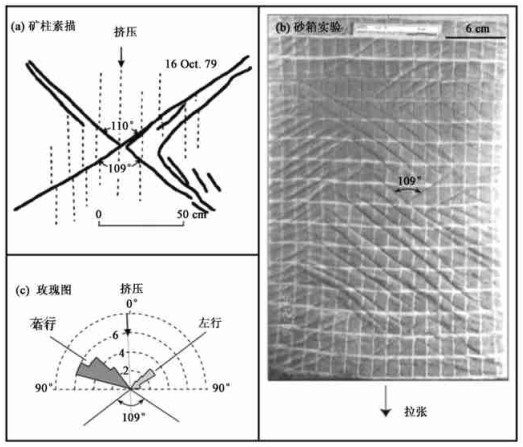
 下载:
下载:
